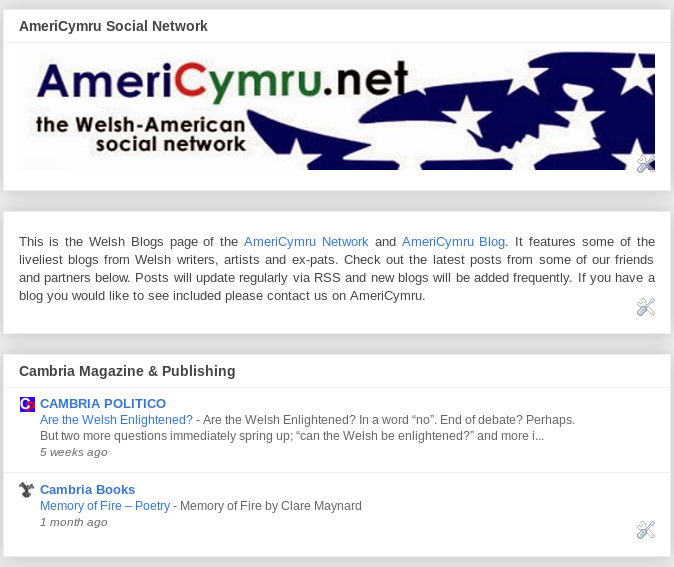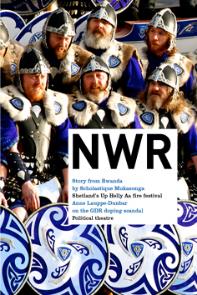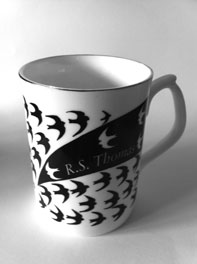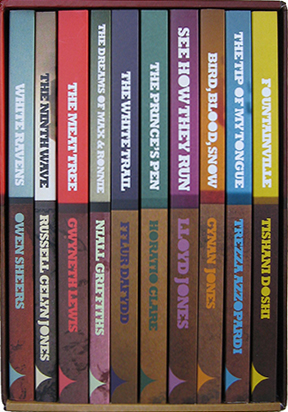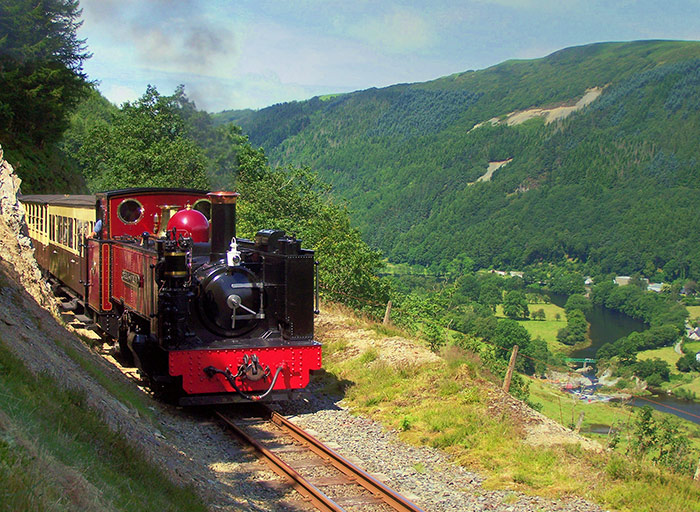Blogs
These incredible coincidences occurred on the Menai Strait, the treacherous, narrow stretch of shallow tidal water which separates the island of Anglesey from the mainland of Wales;
December 5th 1664 - a ship sunk in the Menai Strait and the only survivor was Hugh Williams.
December 5th 1785 - a ship sunk in the Menai Strait and the only survivor was Hugh Williams.
December 5th 1820 - a ship sunk in the Menai Strait and the only survivor was Hugh Williams.
Today is the feast day of Saint Justinian of Ramsey Island, Abbot of St David's Cathedral (pictured)
Saint Justinian of Ramsey Island c.550
Tradition states that he was a Breton nobleman who settled on the Ramsey Island as a hermit. He was visited by Saint David who was so impressed with his holiness that he made him Abbot of St David's Cathedral. Justinian however, became frustrated with the poor attitude of the monks at St Davids and returned to Ramsey Island with his most loyal monks to establish a more holy spiritual community.
Legend has it that he was eventually murdered by some monks fed up with his strict regime, by beheading him. Apparently he picked up his head and crossed Ramsey Sound walking on the water carrying his head in his arms, his body was buried in the small ruined chapel which still stands on the mainland at St Justinian's and later transported to the shrine of Saint David in St David's Cathedral. The Anglican church at Llanstinan, near Fishguard, is also dedicated to him.
Born on this day 1859 in Llandovery.
Edward John Lewis is remembered as winning his one and only cap for Wales, playing half-back in the first ever Welsh rugby international. Wales lost comprehensively and Lewis was never picked again. Instead he concentrated on his career as a consultant surgeon, later taking a post as Senior Resident Medical Officer at Great Ormond Street Hospital.
Match Report;
The game is noted for it's chaotic organisation and it didn't help was that the RFU insisted that the match was played on the same day that Swansea were playing Llanelli in a semi-final cup-tie thus depriving Wales of several players. The players had never played together before and one player, Major Richard Summers from Haverfordwest was selected on the performances for his school.
The players changed in The Princess of Wales a pub, half a mile walk from the ground and played in walking boots, high neck jerseys and knee length knickers. Also, as two of those expected to play didn't turn up, two bystanders, with tenuous Welsh links were roped in to play. The final team that took to the pitch consisted of 8 Welshmen, 4 Englishmen, 2 Irishmen and an Australian.
Rumour has it that the Welsh team had been drinking heavily and needless to say, they lost heavily, 82-0 under modern scoring values. It could have been worse as England had a try disallowed when England captain Lennard Stokes put Hunt in for a score by throwing a colossal pass, the umpires decision was that a long pass was not fair play.
At the dinner following the match the England captain, Leonard Stokes, said “I’ve seen enough to know that you Welshmen will be hard to beat in a few years’ time when you get together”. In the critical aftermath of the match the WRFU was founded a month later at the Castle Hotel, Neath on 12th March 1881.
Strumble Head Lighthouse stands imposingly on Ynysmeicl (St. Michael's Island), an islet to the west of Fishguard, it is connected to the mainland by a by a footbridge across the narrow sound.
The station was built in 1908 by Trinity House for the greater safety of sea traffic between Ireland and the new Fishguard Harbour. The new light formed a link with the existing South Bishop light, 18 miles to the south-west, guarding what is a very dangerous stretch of coast, some 60 vessels are known to have been lost along it in the 19th Century alone.
The original revolving lens system weighed 4½ tons, supported in a bath of mercury to reduce friction. A massive clockwork mechanism rotated it, driven by a quarter-ton weight which, suspended on a cable, dropped gradually down a cylinder running from top to bottom through the tower and had to be re-wound every 12 hours. The optical system was replaced by more compact equipment when Strumble Head lighthouse was fully electrified in 1965.
Ynsymeicl's isolation and steep slopes, presented building problems, with building material and supplies, having to be swung across by jackstay cable. The handrail of the footbridge and the steps to it also had a special purpose, as the pipeline to carrying oil to the lighthouse.
The lighthouse was converted to unmanned automatic operation in 1980 and is now monitored from the Operations and Planning Centre at Harwich.
This is the Welsh Blogs page of the AmeriCymru Network and AmeriCymru Blog. It features some of the liveliest blogs from Welsh writers, artists and ex-pats. Check out the latest posts from some of our friends and partners below. Posts will update regularly via RSS and new blogs will be added frequently. If you have a blog you would like to see included please contact us on AmeriCymru.
Back to Welsh Literature page >

In this article Julie talks about nicknames in Wales:- " It’s a ‘gift’ which we here in Wales have had for generations - the adaptation of people’s names, derived either from a notable physical feature, or their personal habits, jobs, or pastimes. All done completely without malice, and with mutual appreciation of wit at its best, or silliness at its worst. In fact for many years receiving a nickname from one’s work colleagues and friends was a mark of social inclusion and a sign of popularity. "
Her latest publication is an anthology of short stories - 'Close To You'. Buy 'Close To You' here
,,,,
Have you noticed how, in recent years, people in the public eye have been given nicknames simply by shortening their surnames or adding ‘ers’ to the end? So we have Sir Paul ‘Macca’ McCartney, and David ‘The Hoff’ Hasselhoff. Or couples’ names are blended together, as in ‘Brangelina’ or ‘Posh & Becks’.
The boringness of these names is due possibly to our much more politically correct society, or else it could simply be that none of these people have Welsh families, because, if so, they would have been given much more inventive names.
It’s a ‘gift’ which we here in Wales have had for generations - the adaptation of people’s names, derived either from a notable physical feature, or their personal habits, jobs, or pastimes. All done completely without malice, and with mutual appreciation of wit at its best, or silliness at its worst. In fact for many years receiving a nickname from one’s work colleagues and friends was a mark of social inclusion and a sign of popularity.
My parents’ generation were past masters of the genre, with friends who included ‘Basketass’ – no explanation needed, really; ‘Morgan Bucket’, the origin of which I think had something to do with the shape of his head, and ‘Organ Morgan’ (no relation to Bucket), whose nickname derived not from a reference to any anatomical attribute, but from his musical performances at Sunday chapel.
Best of all, though, was ‘Titty’ Lewis. This chap went through his whole life with this moniker because it was claimed that he was breastfed until he started school. I’ve no idea what his real name was, but there is no evidence to suggest he ever minded this nickname, and, eventually, he was so universally known by it that no-one actually took any notice of its origin or its connotations.
Then there was ‘Gobby’ Davies – not, as one might think, a slangy reference to him talking a lot, but because he started so many sentences with ‘I go’be honest’, while his mate was known as ‘taters n’ gravy’ as he always said that potatoes and gravy was his favourite meal. Yet another friend was called ‘Bonar’ Thomas because apparently, like Bonar Law, the political contemporary of Lloyd George, he talked a lot. For many years my parents referred to a neighbour only as ‘The Widow’, as she moved to the area on the death of her first husband. They continued to call her this even after she re-married, so that her new spouse became confusingly known as ‘The Widow’s husband’.
The local greengrocer was known as ‘Up-and-down Mike’ because his prices varied so much from week to week, and, in my present town, an undertaker was called ‘Ted the Box’, while one of our best known publicans is referred to as ‘Fatty Keys’.
Many of these people are long gone, and with them, possibly, the ability to laugh at each other and themselves and the knowledge that to be given a nickname within the community was a badge of affection and inclusivity rather than the reverse.
My children, however, seem to have inherited the habit from their grandparents. One daughter always calls her younger brother ‘Fatman’, even though he is now very slim, because, as a toddler in a nappy, he resembled a sumo wrestler. He, on the other hand, calls her ‘Gimli’ as her small stature and wild curly hair reminds him, he claims, of the dwarf character in ‘Lord of the Rings’, and our youngest is known to everyone as ‘Titch’ just because she was the last in the line.
A life-long friend of my son is known as ‘The Ginge’ because of his auburn locks, and another is called ‘Dodgy Dave’ because he wheels and deals, even though his real name is Joe. Meanwhile, one of my daughter’s circle is known as ‘Chainsaw Rhys’ to differentiate him from the other Rhys whose skull didn’t have an unfortunate collision with a piece of machinery.
They are already passing the habit on, too. Younger daughter, convinced her sister was expecting a large boy, nicknamed him ‘Tank’. When scans confirmed a girl was on the way, she became ‘Tankini’, although we are all hoping a more regular feminine name will stick once she’s here.
It would be a shame if affectionate nicknames, bestowed with no malice and received as such, were to be sacrificed on the altar of correctness. After all, they haven’t hurt the likes of Twiggy or Whoopi Goldberg, have they?
Julie McGowan
The daguerreotype of Margam Castle taken in 1841 by Calvert Jones is credited with being the first photograph taken in Wales.
Calvert-Jones was born on 4th December 1804 in Swansea. He was a mathematician, painter and photographer, who came from a wealthy Swansea family and was educated at Eton and Oriel College, Oxford. He became rector of Loughor where he developed a great interest in photography, taking many photographs of the Swansea area as well as France and Italy, on his travels. Jones also discovered a technique for taking panoramic photographs by overlapping images.
In 1847, Jones inherited the Heathfield estate in Swansea, which he developed and named Mansel Street after his brother. He died in Bath and was buried at St Mary's Church, Swansea, but the grave was destroyed during the bombings of World War II.
The International Rugby Hall of Fame was created at its inaugural dinner on 4th December 1997 in New Zealand.
The following are its current Welsh inductees;
WALES; Gareth Edwards, Barry John, JPR Williams, Cliff Morgan, Gerald Davies, Carwyn James, Mervyn Davies, Phil Bennett, Gwyn Nicholls and Ieuan Evans.
Born on this day 1936 in Chepstow.
Richard Meade - Olympic gold medal winning equestrian. Meade was a member of Britain's gold medal winning team in the three-day event at both the 1968 and 1972 Summer Olympics and also won the individual gold in 1972, becoming the first British rider to win an individual Olympic gold medal. His international record also includes two gold and two silver World Championship medals and three gold European Championship titles. In 1972, he was voted BBC Wales Sports Personality of the Year.
Kidwelly is one of the finest castles in South-West Wales and situated in a long disputed region, it remains remarkably intact after three centuries of Anglo-Norman/Welsh warfare.
A timeline of the history of Kidwelly Castle;
c.1100 Shortly after the Norman conquest, the lordship of Wales's south western coastal plain was awarded by Henry I, to Roger, Bishop of Salisbury.
1106 Roger built a motte-and-bailey type castle, to defend the road to west Wales on the estuary of the river Gwendraeth, defended on one side by the river and on the other by a deep crescent shaped ditch. Roger also established a Benedictine priory nearby and the burgeoning town of Kidwelly began to develop
1136 The Welsh rose in revolt against the Norman occupation in south Wales. Gruffudd ap Rhys, prince of Deheubarth, rode north to plead for aid from Gwynedd, while his wife, Gwenllian, led a Welsh army against Kidwelly. Gwenllian was defeated and killed at Maes Gwenllian, just north of the castle, by the English under Maurice de Londres.
1159 Rhys ap Gruffudd (The Lord Rhys) took the castle while Henry II was away in France
1163 Henry II returned from France and invaded Deheubarth, stripped Rhys of l his lands and took him prisoner.
1171 Henry II made peace with Rhys. Rhys was to pay a tribute of 300 horses and 4,000 head of cattle but was confirmed in possession of most of the lands he had taken from Norman lords, but not Kidwelly Castle
1189 Henry II died and was succeeded by Richard I. Rhys considered that he was no longer bound by the agreement with Henry and attacked the Norman lordships, capturing Kidwelly as well as the castles of St Clears, Laugharne and Llansteffan.
1197 Rhys died and the castle fell back under English control
1215 Rhys's son Rhys Gryg in alliance with Llywelyn ap Iorweth (Llywelyn the Great) attacked and captured many castles in South Wales including Kidwelly.
1220 The castle was back in English hands under Hawise de Londres,
1231 The castle resisted an attack from Llywelyn ap Iorwerth
Hawise's sons Pain and Patrick de Chaworth then rebuilt much of the earlier castle, creating much of the fortress we see today. In the late 13th century It passed into royal ownership and in the 14th century began to be used as an administrative centre for the powerful Lancaster family.
1403 when it was attacked by Henry Don, a supporter of Owain Glyndwr's rebellion. The town was sacked, but Kidwelly Castle held out.
Though repairs continued over the subsequent centuries, the castle was no longer needed for military purposes and fell into a gradual decay. Unlike many Welsh castles, Kidwelly played no part ion the English Civil War and was eventually purchased by Earls of Cawdor
1927 The castle passed into government care.
In December 1946, the U.K's first Remploy factory was opened, in Bridgend, with the aim of offering work to disabled people. Over the following decades, Remploy established a network of 83 factories across the UK.
Remploy was originally subsidised by the government, however at the beginning of 21st century, it became the policy to encourage disabled people to have mainstream jobs, which resulted in the closure of most Remploy factories.

|
ITS CHRISTMAS! (Well nearly) If you havent found the perfect gift for that special someone yet, have no fear! Seren published a great range of titles this year, with something to suit everyone. Remember to claim your 20% off when you join our online book club .
Books for Everyone
| New Stories From the Mabinogion Box Set - 80 Serens New Stories From the Mabinogion box set contains ten terrific tales by top authors, which means theres one for all readers. Ten Welsh authors have taken the ancient Mabinogion Myth cycle and re-worked them in to modern day tales, taking us to places weird and wonderful along the way.We have reached the orbit of Mars, the Tower of London and the edges of India, travelled in time to WW2 and forward to the near future, seen Iraq in drug-addled dreams, and viewed Wales aslant, from its countryside to its council estates. We have touched on nation-building and personal tragedy, bravery and betrayal. Want to make it extra special? Get the signed set here . Paperback ISBN:9781781721520 |
Coffee Table Books
These beautifully presented books feature glorious full colour photographs and will take pride of place on any coffee table.
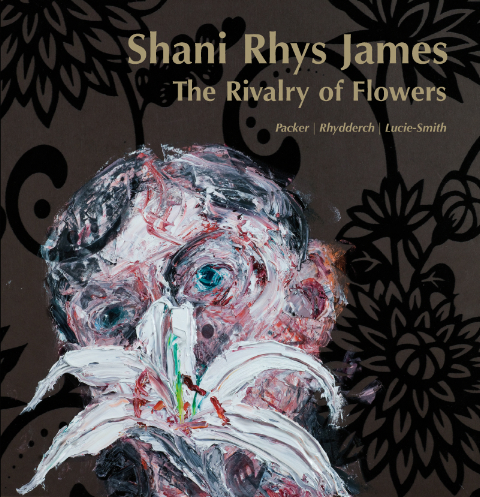 | The Rivalry of Flowers by Shani Rhys James - 29.99 - Save 6 when you buy online A book of 52 stunning new paintings and works by Shani Rhys James, one of Britains leading and most distinctive artists. Her latest work has developed a lighter palette to deal with new subjects of flowers and colourful patterned wallpaper backgrounds. Rhys Jamess paintings continue her exploration of the position of women in society, and in particular how women can be imprisoned by consumerism and the domestic environment. Hardback ISBN: 9781781720615 |
| The Harp in Wales by Bruce Cardwell - 29.99 - Save 6 when you buy online Bruce Cardwells latest book of photography is a celebration of the harp in Wales, an instrument as symbolically key to Welsh identity as the flag itself.The book provides a history of the harp in Wales, including how it grew to prominence, its evolving role in Welsh culture, how it became a central symbol of Welshness, how it has developed as a musical instrument and the booming harp business today. Hardback ISBN: 9781781720806 |
|
Borderlands by Phil Cope - 19.99 -Save 4 when you buy online New Photographs and old tales of the sacred springs, holy wells and spas populating the disputed lands of the Welsh-English border.Richly illustrated in colour throughout the wells from Cheshire to Monmouthshire, from the Dee to the Severn are here displayed in all their glory, be they in remote countryside or city centre. Hardback ISBN:9781781720608 |
Books for The Poetry Lover
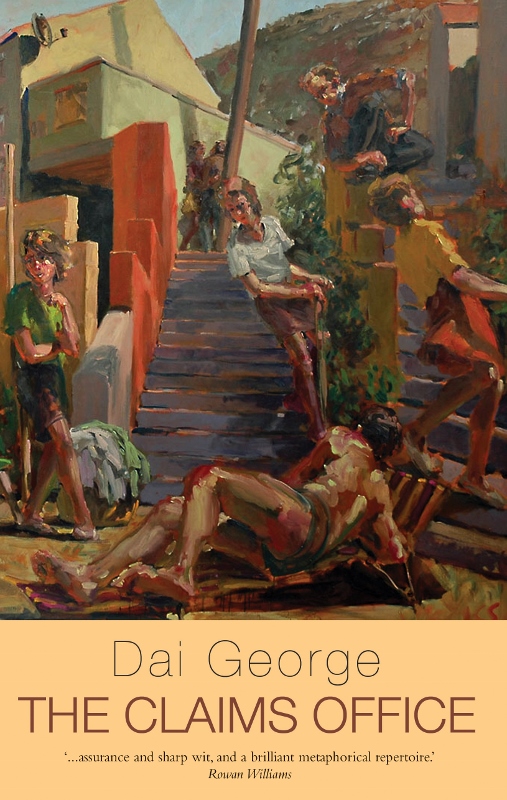 The Claims Office by Dai George - 8.99 -Save 1.80 when you buy online The Claims Office by Dai George - 8.99 -Save 1.80 when you buy onlineDai George is primarily an urban poet, he's drawn to socio-political themes and is fascinated by history and how this effects character, both his own in the 21st century, this is evident within his poetry. There are lively pieces about London and New York: Metroland and New York on a Shoestring; skewed loves poems: Plans with the Unmet Wife. 'His method is mostly straightforward narrative but the textures and imagery are often elaborate and strange. This rich surface is undercut by an interesting attitude: a mix of rebellious energy and unflinching satire. Paperback ISBN:9781781720905 |
| R.S Thomas:Poems to Elsi , ed. Damien Walford Davies - 9.99 Save 2 when you buy online Share the love with these 52 poems (two previously unpublished) by Thomas to his wife, the distinguished artist Mildred E Eldridge - known as Elsi - from early meditations on their relationship to the elegies following her death.This revelatory collection dramatises the changing dynamics of a complex and vitally creative relationship. Poems on marriage, cohabitation, birthdays, anniversaries, family and bereavement offer a candid portrait of emotional intimacy, desire, the painful process of ageing, and of loss. Paperback ISBN:9781781721117 |
| In Reality: Selected Poems by Jean Portante - 9.99 -Save 2 when you buy online In Reality is the first English translation of the poetry of Jean Portante,a lyric poet, and also one who has something to say to an international audience. As a Francophone Luxemburger of Italian descent, his poetry works at the spaces between European cultures and is concerned with themes of identity, politics, language, Europe, the divide between politics and everyday life. This dual language edition collects work from the last 20 years, including poems from his 2013 collection, Aprs le tremblement . Translated by Zo Skoulding, Paperback ISBN:9781781720653. |
| The Visitations by Kathryn Simmonds - 8.99 - Save 1.80 when you buy online The Visitations is the follow-up to Kathryn Simmonds Forward Prize-winning debut, Sunday at the Skin Launderette . An appealing voice masks darker themes and worlds unseen with subtle shifts of language and perspective. The tone is often simultaneously satirical and elegiac and the collection abounds with sudden moments of strange illumination: a lime tree strikes up a conversation; a life coach finds an old passport; an infant teeters on the brink of speech. The Visitations is a meeting place for the physical and metaphysical, questions of new motherhood are set against those of faith, and the larger conundrum of how to live. Paperback ISBN:9781781721162 |
Books for the Explorer
Cant afford a round the world ticket? Give the gift of travel and let your loved one explore the world from the comfort of their armchair.
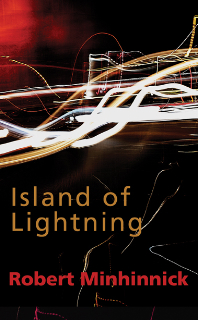 Island of Lightning by Robert Minhinnick - 9.99 -Save 2 when you buy online Island of Lightning by Robert Minhinnick - 9.99 -Save 2 when you buy onlineTravel around south Wales, Argentina, China, Finland, Iraq, Tuscany, Piemonte, New York, Zagreb, Lithuania and the lightning island of Malta with Robert Minhinnicks latest book of travel essays. Attractions include the annual Elvis convention in Porthcawl, Neolithic sculptures, the cruelties of late twentieth century communism and its aftermath, rugby union, the Argentinian writer Alfonsina Storni, poets playing football, the body of a saint and the definition of cool. His themes are big ones: the relationship of man and landscape, man and time, man and nature, immigration and war, in one sense ultimately humankind itself. Paperback ISBN:9781781721292 |
| Edging the Estuary byPeter Finch - 9.99 -Save 2 when you buy online Peter Finch sets out to explore his heritage, walking both sides of the Severn Estuary.On his journey he sees the estuary as border, a highway for trade and ideas, an industrial zone, and a place for people to spend their leisure.Finch takes in villages and cities, power stations and fishermen, castles and caravans, leg-aching walks and deckchairs on the beach, exploring both busy tourst attractions and secret havens along some of the most beautiful coastline in Britain. Paperback ISBN:9781781720844 |
| Everything I Have Always Forgotten by Owain Hughes - 9.99 -Save 2 when you buy online Everything I Have Always Forgotten is the story of Owain Hughes childhood.His parents, novelist Richard Hughes and artist Frances Bazley, intended to encourage independence and self-reliance through a policy of benign neglect, allowing for quixotic childhood adventures. His enchanting stories of boating, horse-riding and walking include a three day hike through Snowdonia by the 12 year old Owain and cumulate in him being marooned for two weeks on Bardsey Island, off the north Wales coast, with no way of contacting home. Paperback ISBN:9781781720998 |
| Metropoetica , ed. ZoSkoulding- 9.99 -Save 2 when you buy online Explore Europes capital cities through poetry with Metropoetica . What does writing poetry have in common with walking in the city? What lost paths, dark alleys and chance connections are encountered? How do these change the maps by which cities are known and by which new poetries may be discovered? Metropoetica is a collaboration of women writing and walking in different cities across Europe in response to these questions. The contributing poets and translators include Ingmara Balode (Riga, Latvia), Julia Fiedorczuk (Warsaw, Poland), Sanna Karlstrm (Helsinki, Finland), Ana Pepelnik (Ljubljana, Slovenia), Zo Skoulding (Bangor, Wales), Sigurbjrg Thrastardottir (Reykjavik, Iceland), and Elzbieta Wjcik-Leese (Krakw, Poland). Paperback ISBN:9781781721285 |
Books for the Crime Addict
Send a shiver down their spine with our true crime books.
| 9.99 - Save 2 when you buy online The Pembrokeshire Murders , tells the true story of Operation Ottawa, the cold case investigation of the notorious unsolved Pembrokeshire Murders. Detective Chief Superintendent Steve Wilkins tells how cutting edge forensic techniques, fibres from a glove and an unlikely appearance on the ITV program, Bullseye , lead to the conviction of John Cooper.The dramatic timeline involves psychological profiling, intimidation by Cooper, the relationship between police and media in the arrest and the predicament of the victims' families during the long years when the cases remained unsolved. Paperback ISBN:9781781728000 |
| Disturbance by Ivy Alvarez - 9.99 -Save 2 when you buy online Disturbance is an imaginative retelling of and a response to actual events. It chronicles a brutal multiple-homicide, a case of domestic violence that ends in tragedy, an entire family gunned down by its patriarch.The book features a kaleidoscope of voices. Each poem is a piece of evidence, We hear from the family and witness how the fathers possessive attitude escalates into psychosis and eventually violence. Then we experience the chaotic aftermath: the should of, would of, could of of the authorities, police and neighbours, who all might have acted to prevent this tragedy. Paperback ISBN:9781781720875 |
Books for the Fiction Fanatic
Get lost in someone elses world this Christmas with one of our fantastic fiction titles.
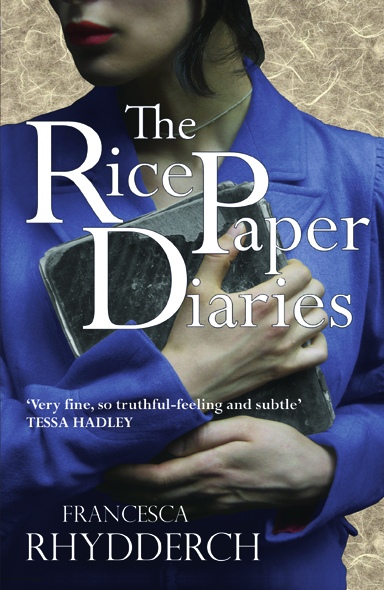 | The Rice Paper Diaries by Francesca Rhydderch - 8.99 -Save 1.80 when you buy online It is spring 1940, and newly wed Elsa Jones is finding her way in Hong Kongs ex-pat society. Lonely and homesick, she finds an ally in her amah Lin, who has travelled downriver from her native village in Canton, but their friendship is clouded by Lins own longing to be reunited with her young sister and the simpler life of her childhood.When Hong Kong falls to the Japanese, Elsa and her husband Tommy are captured and interned in a makeshift camp on the southern side of the island. Along with the rest of Hong Kongs European elite, they have to knuckle down to the task of survival in hostile surroundings. Paperback ISBN:9781781720516 |
| Ibrahim & Reenie by David Llewellyn - 8.99 -Save 1.80 when you buy online Ibrahim is a young Muslim guy walking from Cardiff to London. He has his own reasons, and his own mental and physical struggles to deal with along the way. What he hadnt counted on was a chance meeting with 75-year-old East Londoner Reenie before hes hardly started. With her lifes luggage in a shopping trolley, complete with an orange tent and her pet cockatiel, Reenie is also walking the M4, and not for charity. As they share a journey their paths stretch out before and behind them into the personal and political turns of European history in ways neither could have foreseen. Paperback ISBN:9781781720813 |
| The Colour of Dawn by Yanick Lahens - 8.99 -Save 1.80 when you buy online Port au Prince, Haiti. The police roam the streets and no-one is safe. Fignol, musician, political radical is missing. His sisters Joyeuse and Angelique search for their young brother amid the colourful bustle, urban deprivation and political tension of the city. Eventually they will find him, but in the process they will also have found more about themselves than they wanted to know. The Colour of Dawn is the story of one day and three lives in a city where love is hard to find, life is cheap and death is all too familiar. It is the tense, passionate and vividly told story of small victories of hope in the face of a seemingly impossible fight against a monolithic regime. Translated by Alison Layland. Paperback ISBN:9781781720578 |
Books for the Coffee Break
These books are made up of collections of short stories, making perfect reading for a spare 15 minutes.
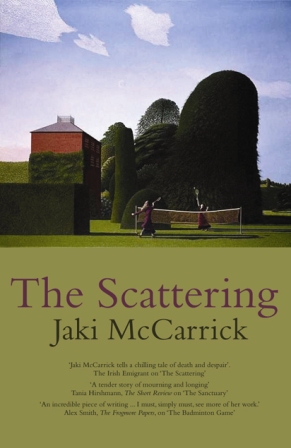 The Scattering by Jaki McCarrick - 8.99 -Save 1.80 when you buy online The Scattering by Jaki McCarrick - 8.99 -Save 1.80 when you buy onlineA collection of nineteen stories, exploring states of liminality: life on the Irish border, dual identities, emigration, being between states - certainty and doubt, codependency and freedom. Some explore themes of catastrophe and constraint. All explore what it means to be alive in a fraught and ever-changing world. The Visit won the Wasafiri Prize for new fiction, and many have been published to much acclaim in literary magazines. Paperback ISBN:9781781720325 |
| All the Souls by Mary Ann Constantine -8.99-Save 1.80 when you buy online Two doctors and a folklorist meet in northern Brittany in 1898, determined to prove that leprosy still exists. But their ardour for collecting evidence draws them into a dark, watchful landscape where superstition is rife. Many of the stories in All the Souls hover round themes of collecting and recovering the past. From poignant and dangerous obsessions with the iconic (a Romano-British figurine; a carved wooden Christ-child; a bronze angel) to direct, often puzzled conversations with ghosts, the characters in this book all strive to make contact with the impossible. Paperback ISBN:9781781720622 |
Award Worthy
These books have all won or been nominated for major prizes this year
| Clueless Dogs by Rhian Edwards - 8.99 -Save 1.80 when you buy online Winner of Wales Book of the Year 2013 Paperback ISBN:9781854115737 |
| She Inserts the Key by Marianne Burton - 8.99 -Save 1.80 when you buy online Shortlisted for the Felix Dennis Forward Prize for Best First Collection Paperback ISBN:9781781720387 |
| Burying the Wren by Deryn Rees Jones - 8.99 -Save 1.80 when you buy online In Burying the Wren Deryn Rees-Jones returns to familiar preoccupations but with a new clarity and maturity of vision. With intense lyricism she calls on the Roethkean 'small things' of the universe -- truffles, slugs, trilobites, birds, stones, feathers, flowers, eggs -- which, mysterious, and magical as well as ordinary -- she sets up against loss. Her sequence of 'Dogwoman' poems, which draws on the work of artist Paula Rego, is an extended elegy to her late husband, the poet and critic Michael Murphy. Above all these are poems of the body, ...the blue heartstopping pulse at the wrist, which are alive to the world and the transformative qualities of love. Paperback ISBN:9781854115768 |
 https://www.indiegogo.com/projects/learnirish-com-a-complete-online-course
https://www.indiegogo.com/projects/learnirish-com-a-complete-online-course
We received the following message today from Peter Stranney at LearnIrish.com . Peter studied Irish at postgraduate level in Aberystwyth University in Wales and is now spearheading a campaign to make vital online resources available to Irish language learners. We strongly urge all our members and supporters to circulate the indiegogo appeal ( linked below ) to anyone they know who is interested in preserving the Irish language. The campaign is looking for future students and subscribers and the rates are very reasonable. We at AmeriCymru would like to take this opportunity to wish LearnIrish.com every success with their fundraising campaign.

The Irish language is recognised as being one of the oldest written languages in the world but is classified by Unesco as being 'definitely endangered'. On average, a language dies every fortnight and it's predicted that half of the world's 7000 languages will die out within the next 100 years. LearnIrish.com aims to help make the Irish language and learning resources accessible to more people around the world.
If funded, LearnIrish.com hopes to deliver a comprehensive Irish language course complete with games and quizzes to monitor progress. They've set a goal of $7000, with two days into the campaign they've almost reached 20% of their target but need as much support as possible to make it to the end.
Funding options start at just $8 for 12 months' access. The develeper, Peter Stranney, has been learning Irish for over 7 years and recognises the difficulty faced by people who want to further their knowledge of the language. He studied Irish at postgraduate level in Aberystwyth and lived in the Welsh speaking village of P ontrhydfendigaid. He has a love of the Welsh language and culture and was inspired by seeing how strong the Welsh language was - his team mates would have to translate the half time talks when he played for P ontrhydfendigaid FC!
Peter aims to develop an online course which is easy to use and with a clear route for progression. He has native Irish speakers ready to help with the development of the course but just needs the funding to make it possible. He'll face an uphill struggle raising the money with just 23 days to go and another battle to deliver the course but he's no stranger to hard work.
Check out the campaign on indiegogo and help support this very worthy cause
A View of the Rheidol Valley.
The University town of Aberystwyth lies on the west coast of Wales, half way down Cardigan Bay. It is the only sizeable centre of population in between Caernarvon in North Wales, Carmarthen to the south or Shrewsbury over the border 70 miles to the east.
A trip on the Vale of Rheidol Railway would make a very good introduction to the Rheidol valley. It runs for about 6 miles along the bottom of the valley to Capel Bangor, then begins to climb the side of the valley for a further 6 miles to Devils Bridge. As soon as the train pulls of the station, buildings of the National Library of Wales and the University can be seen on the hill.
For the first half of the trip, the valley is broad and the fields are grazed by cattle, some of it parkland of the Gogerddan Mansion which is now IBERS. (Institute of Biological, Environmental and Rural Sciences, which has its routes in the old grassland and plant breeding centre and the old Welsh Agricultural college). The Aberystwyth show is normally held here at the start of June.
As soon as Capel Bangor is passed, the train heads into the trees at the side of the valley, passing the Rheidol Riding Stables and begins the long climb to Devils Bridge, the twists and turns in the tracks alternately mirror the meanders of the river and skirt around the foot of steep side valleys, such as the one at Aberffrwd where the lane climbs steeply to the main road 800 feet above.
The Vale of Rheidol Railway with Rheidol falls below and the Stag on the hillside above.
The meandering Rheidol Reservoir is the next major feature in the valley bottom which catches the outflow from the hydro-electric power station, above which a mine spoil heap can be seen in the shape of a Stag. At the head of the reservoir are the Rheidol falls and fish Ladder and above here the railway passes through some of the surface workings of Rheidol united mines which connect with surface workings of a mine once known as 'Silver Mountain' which can be seen beside the A4120 above. In all these workings are almost 1000 feet deep.
Above the Rheidol falls the valley bottom continues to narrow (as does the road) until the waste heaps of the Cwm Rheidol mine are seen on the north side of the valley, ore was once lifted from here by a rope way to the railway line to be taken to Aberystwyth for export. Below here is a popular spot to bathe in the river and a footbridge crosses a narrow gorge.
As the train winds its way into Devils Bridge, the Rheidol valley is deep and lined with Oak woodlands, where it is thought that Red Squirrels and Pine Martens could exist. The valley turns a right angle to the north here, an example of the Geological phenomenon 'River capture'. Long ago, before the last Ice age, the upper reaches of the Rheidol were once the headwaters of the Teifi, which suffered losses to 2 rives cutting their gorges upstream under the ice.
Devils Bridge is known in Welsh as Pontarmynach, the 'Devils Bridge' was actually built by monks in 1087. This bridge supports the foundations of its replacement, built in about 1750, a bridge that was able to carry a carriage, and a modern bridge is now sitting above these. 2 spectacular walks start here to see the bridges, gorge and Waterfalls which William Wordsworth compared to Viamala in Switzerland. http://www.devilsbridgefalls.co.uk/index.php?page=109
North of Devils Bridge the Rheidol gorge heads for Ponterwyd where the upland country is more open and the upper Reservoirs of the Hydro scheme can be found.
Cambrian Safaris offers tours from Devils Bridge station to explore the upper reaches of the Rheidol valley and the surrounding hillsides from where there are stunning views back to the coast. It is possible to take a train from Aberystwyth at 10.30, arrive in Devils Bridge at 11.30, and enjoy a 4 hour tour and return in time for the train back to Aberystwyth at 4.15.
Born on this day 1910 in Oswestry
Dr. Robert Arthur Hughes, who was a medical missionary for the Presbyterian Church of Wales. He trained as a surgeon in London prior to working at the Welsh Mission Hospital in Shillong (the capital of the state of Assam in India), from 1939-1969, where under his direction, the hospital was able to employ more nurses than the rest of the hospitals in Assam combined. He also;
* Set up a travelling unit to dispense medicines and provide aid to the surrounding provinces.
* Worked on trying to get rid of malaria from the area.
* Introduced a treatment to alleviate pain from peptic ulcers.
* Introducing a rickets treatment in the infant population,
* Recognizing a protein calorie deficiency disorder called kwashiorkor in the Indian population,
* Founding the area’s first blood bank.
* Performing the first lower segment Caesarean section without antibiotics in India.
* Expanding educational training for medical and nursing organizations.
On 3rd December 1935, Felinfoel brewery produced Britain's first ever can of beer.
Felinfoel was the first brewery outside the USA to commercially can beer and it was to transform Britains alcohol buying habits. The cans were made from tinplate, produced in South Wales, which from the late 18th century until the early 20th dominated the world's production. So much so that in the early 1890s, 80% of all tinplate was produced in South Wales.
On 3rd December 2011, Shane Williams scored his 58th Test try in his final Welsh appearance, with the last move of the match against Australia. He scored his try with a celebratory somersault and was treated to a standing ovation at the final whistle.
Born on this day 1925 in Crynant, near Neath
Roy John - former Wales and Lions rugby international. John was capped 19 times for Wales and was a member of the 1950 and 1952 Grand Slam winning teams as well the Welsh side that beat New Zealand in 1953. In 1950 he was also selected for the Lions tour to New Zealand and Australia, where his excellent ability in the line out as well as his swerve and dummy, earned him the nickname “The King”. John had a powerful standing leap and was reported to be able to leap up and grab the crossbar, which is 10 ft 6ins high.
On 3rd December 1984, the first McDonald's fast food restaurant in Wales opened in Cardiff.
* The McDonald's Corporation is the world's largest chain of hamburger fast food restaurants, with approximately 68 million daily customers in 119 countries across 35,000 outlets, employing more than 1.7 million people.
* The company began in 1940 as a barbecue restaurant operated by Richard and Maurice McDonald;
* In 2012, McDonald's Corporation had annual revenues of $27.5 billion, and profits of $5.5 billion.

